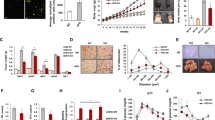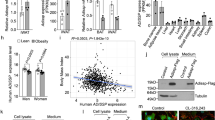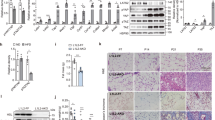Abstract
Activins are secreted proteins members of the transforming growth factor-β family. They are involved in many biological responses including regulation of apoptosis, proliferation and differentiation of different cell types. Activins A, B and AB are highly expressed in adipose tissue, and in this review we will illustrate that activins have a role in several steps of physiological and pathological development of adipose tissue. Activin A has been shown to be a critical regulator of human adipocyte progenitor proliferation and a potent inhibitor of their differentiation. Activin A could also be a mediator of fibrosis observed in obese adipose tissue. Activin B/AB is proposed as a new adipokine having a role in energy balance and insulin insensitivity associated with obesity. Therefore, activin pathway could represent a potential therapeutic target both for controlling the size and the phenotype of the adipose precursor pool and for obesity-associated metabolic complications.
This is a preview of subscription content, access via your institution
Access options
Subscribe to this journal
Receive 12 print issues and online access
$259.00 per year
only $21.58 per issue
Buy this article
- Purchase on Springer Link
- Instant access to full article PDF
Prices may be subject to local taxes which are calculated during checkout


Similar content being viewed by others
References
Maumus M, Sengenes C, Decaunes P, Zakaroff-Girard A, Bourlier V, Lafontan M et al. Evidence of in situ proliferation of adult adipose tissue-derived progenitor cells: influence of fat mass microenvironment and growth. J Clin Endocrinol Metab 2008; 93: 4098–4106.
Weisberg SP, McCann D, Desai M, Rosenbaum M, Leibel RL, Ferrante Jr AW . Obesity is associated with macrophage accumulation in adipose tissue. J Clin Invest 2003; 112: 1796–1808.
Xu H, Barnes GT, Yang Q, Tan G, Yang D, Chou CJ et al. Chronic inflammation in fat plays a crucial role in the development of obesity-related insulin resistance. J Clin Invest 2003; 112: 1821–1830.
Divoux A, Tordjman J, Lacasa D, Veyrie N, Hugol D, Aissat A et al. Fibrosis in human adipose tissue: composition, distribution, and link with lipid metabolism and fat mass loss. Diabetes 2010; 59: 2817–2825.
Hauner H, Entenmann G, Wabitsch M, Gaillard D, Ailhaud G, Negrel R et al. Promoting effect of glucocorticoids on the differentiation of human adipocyte precursor cells cultured in a chemically defined medium. J Clin Invest 1989; 84: 1663–1670.
Spalding KL, Arner E, Westermark PO, Bernard S, Buchholz BA, Bergmann O et al. Dynamics of fat cell turnover in humans. Nature 2008; 453: 783–787.
Phillips DJ . Activins, inhibins and follistatins in the large domestic species. Domest Anim Endocrinol 2005; 28: 1–16.
Phillips DJ, de Kretser DM . Follistatin. A multifunctional regulatory protein. Front Neuroendocrinol 1998; 19: 287–322.
Nakamura T, Takio K, Eto Y, Shibai H, Titani K, Sugino H . Activin-binding protein from rat ovary is follistatin. Science 1990; 247: 836–838.
Lee SJ, McPherron AC . Regulation of myostatin activity and muscle growth. Proc Natl Acad Sci USA 2001; 98: 9306–9311.
Bessa PC, Casal M, Reis RL . Bone morphogenetic proteins in tissue engineering: the road from laboratory to clinic, part II (BMP delivery). J Tissue Eng Regen Med 2008; 2: 81–96.
Tsuchida K, Nakatani M, Hitachi K, Uezumi A, Sunada Y, Ageta H et al. Activin signaling as an emerging target for therapeutic interventions. Cell Commun Signal 2009; 7: 15.
Feng XH, Derynck R . Specificity and versatility in tgf-beta signaling through Smads. Annu Rev Cell Dev Biol 2005; 21: 659–693.
Bao YL, Tsuchida K, Liu B, Kurisaki A, Matsuzaki T, Sugino H . Synergistic activity of activin A and basic fibroblast growth factor on tyrosine hydroxylase expression through Smad3 and ERK1/ERK2 MAPK signaling pathways. J Endocrinol 2005; 184: 493–504.
de Guise C, Lacerte A, Rafiei S, Reynaud R, Roy M, Brue T et al. Activin inhibits the human Pit-1 gene promoter through the p38 kinase pathway in a Smad-independent manner. Endocrinology 2006; 147: 4351–4362.
Zaragosi LE, Wdziekonski B, Villageois P, Keophiphath M, Maumus M, Tchkonia T et al. Activin a plays a critical role in proliferation and differentiation of human adipose progenitors. Diabetes 2010; 59: 2513–2521.
Sethi JK . Activatin human adipose progenitors in obesity. Diabetes 2010; 59: 2354–2357.
Stewart A, Guan H, Yang K . BMP-3 promotes mesenchymal stem cell proliferation through the TGF-beta/activin signaling pathway. J Cell Physiol 2010; 223: 658–666.
Ota F, Maeshima A, Yamashita S, Ikeuchi H, Kaneko Y, Kuroiwa T et al. Activin A induces cell proliferation of fibroblast-like synoviocytes in rheumatoid arthritis. Arthritis Rheum 2003; 48: 2442–2449.
Turner NJ, Jones HS, Davies JE, Canfield AE . Cyclic stretch-induced TGFbeta1/Smad signaling inhibits adipogenesis in umbilical cord progenitor cells. Biochem Biophys Res Commun 2008; 377: 1147–1151.
Horie T, Ono K, Kinoshita M, Nishi H, Nagao K, Kawamura T et al. TG-interacting factor is required for the differentiation of preadipocytes. J Lipid Res 2008; 49: 1224–1234.
Sjoholm K, Palming J, Lystig TC, Jennische E, Woodruff TK, Carlsson B et al. The expression of inhibin beta B is high in human adipocytes, reduced by weight loss, and correlates to factors implicated in metabolic disease. Biochem Biophys Res Commun 2006; 344: 1308–1314.
Carlsson LM, Jacobson P, Walley A, Froguel P, Sjostrom L, Svensson PA et al. ALK7 expression is specific for adipose tissue, reduced in obesity and correlates to factors implicated in metabolic disease. Biochem Biophys Res Commun 2009; 382: 309–314.
Magnusson B, Svensson PA, Carlsson LM, Sjoholm K . Activin B inhibits lipolysis in 3T3-L1 adipocytes. Biochem Biophys Res Commun 2010; 395: 373–376.
Hoggard N, Cruickshank M, Moar KM, Barrett P, Bashir S, Miller JD . Inhibin betaB expression in murine adipose tissue and its regulation by leptin, insulin and dexamethasone. J Mol Endocrinol 2009; 43: 171–177.
Brown CW, Houston-Hawkins DE, Woodruff TK, Matzuk MM . Insertion of Inhbb into the Inhba locus rescues the Inhba-null phenotype and reveals new activin functions. Nat Genet 2000; 25: 453–457.
Li L, Shen JJ, Bournat JC, Huang L, Chattopadhyay A, Li Z et al. Activin signaling: effects on body composition and mitochondrial energy metabolism. Endocrinology 2009; 150: 3521–3529.
Alessi MC, Bastelica D, Morange P, Berthet B, Leduc I, Verdier M et al. Plasminogen activator inhibitor 1, transforming growth factor-beta1, and BMI are closely associated in human adipose tissue during morbid obesity. Diabetes 2000; 49: 1374–1380.
Allen DL, Cleary AS, Speaker KJ, Lindsay SF, Uyenishi J, Reed JM et al. Myostatin, activin receptor IIb, and follistatin-like-3 gene expression are altered in adipose tissue and skeletal muscle of obese mice. Am J Physiol Endocrinol Metab 2008; 294: E918–E927.
Guo T, Jou W, Chanturiya T, Portas J, Gavrilova O, McPherron AC . Myostatin inhibition in muscle, but not adipose tissue, decreases fat mass and improves insulin sensitivity. PLoS One 2009; 4: e4937.
Yadav H, Quijano C, Kamaraju AK, Gavrilova O, Malek R, Chen W et al. Protection from obesity and diabetes by blockade of TGF-beta/Smad3 signaling. Cell Metab 2011; 14: 67–79.
Zamani N, Brown CW . Emerging roles for the transforming growth factor-{beta} superfamily in reg. Endocr Rev 2011; 32: 387–403.
Flanagan JN, Linder K, Mejhert N, Dungner E, Wahlen K, Decaunes P et al. Role of follistatin in promoting adipogenesis in women. J Clin Endocrinol Metab 2009; 94: 3003–3009.
Permana PA, Nair S, Lee YH, Luczy-Bachman G, Vozarova De Courten B, Tataranni PA . Subcutaneous abdominal preadipocyte differentiation in vitro inversely correlates with central obesity. Am J Physiol Endocrinol Metab 2004; 286: E958–E962.
Isakson P, Hammarstedt A, Gustafson B, Smith U . Impaired preadipocyte differentiation in human abdominal obesity: role of Wnt, tumor necrosis factor-alpha, and inflammation. Diabetes 2009; 58: 1550–1557.
Lacasa D, Taleb S, Keophiphath M, Miranville A, Clement K . Macrophage-secreted factors impair human adipogenesis: involvement of proinflammatory state in preadipocytes. Endocrinology 2007; 148: 868–877.
Keophiphath M, Achard V, Henegar C, Rouault C, Clement K, Lacasa D . Macrophage-secreted factors promote a profibrotic phenotype in human preadipocytes. Mol Endocrinol 2009; 23: 11–24.
Bourlier V, Zakaroff-Girard A, Miranville A, De Barros S, Maumus M, Sengenes C et al. Remodeling phenotype of human subcutaneous adipose tissue macrophages. Circulation 2008; 117: 806–815.
Mohan A, Asselin J, Sargent IL, Groome NP, Muttukrishna S . Effect of cytokines and growth factors on the secretion of inhibin A, activin A and follistatin by term placental villous trophoblasts in culture. Eur J Endocrinol 2001; 145: 505–511.
van der Kruijssen CM, Feijen A, Huylebroeck D, van den Eijnden-van Raaij AJ . Modulation of activin expression by type beta transforming growth factors. Exp Cell Res 1993; 207: 407–412.
Phillips DJ, de Kretser DM, Hedger MP . Activin and related proteins in inflammation: not just interested bystanders. Cytokine Growth Factor Rev 2009; 20: 153–164.
Gounarides JS, Korach-Andre M, Killary K, Argentieri G, Turner O, Laurent D . Effect of dexamethasone on glucose tolerance and fat metabolism in a diet-induced obesity mouse model. Endocrinology 2008; 149: 758–766.
Bourlier V, Sengenès C, Zakaroff-Girard A, Decaunes P, Wdziekonski B, Galitzky J, Villageois P et al. TGFbeta family members are key mediators in the induction of myofibroblast phenotype of human adipose tissue progenitor cells by macrophages. Plos One 2012. (in press).
Sethi JK, Vidal-Puig AJ . Thematic review series: adipocyte biology. Adipose tissue function and plasticity orchestrate nutritional adaptation. J Lipid Res 2007; 48: 1253–1262.
Tsuchida K, Sunada Y, Noji S, Murakami T, Uezumi A, Nakatani M . Inhibitors of the TGF-beta superfamily and their clinical applications. Mini Rev Med Chem 2006; 6: 1255–1261.
Jones KL, Mansell A, Patella S, Scott BJ, Hedger MP, de Kretser DM et al. Activin A is a critical component of the inflammatory response, and its binding protein, follistatin, reduces mortality in endotoxemia. Proc Natl Acad Sci USA 2007; 104: 16239–16244.
Vallet S, Mukherjee S, Vaghela N, Hideshima T, Fulciniti M, Pozzi S et al. Activin A promotes multiple myeloma-induced osteolysis and is a promising target for myeloma bone disease. Proc Natl Acad Sci USA 2010; 107: 5124–5129.
Author information
Authors and Affiliations
Corresponding author
Ethics declarations
Competing interests
The author declares no conflict of interest.
Rights and permissions
About this article
Cite this article
Dani, C. Activins in adipogenesis and obesity. Int J Obes 37, 163–166 (2013). https://doi.org/10.1038/ijo.2012.28
Received:
Revised:
Accepted:
Published:
Issue Date:
DOI: https://doi.org/10.1038/ijo.2012.28
Keywords
This article is cited by
-
Platelet-rich plasma respectively reduces and promotes adipogenic and myofibroblastic differentiation of human adipose-derived stromal cells via the TGFβ signalling pathway
Scientific Reports (2017)
-
Follistatin N terminus differentially regulates muscle size and fat in vivo
Experimental & Molecular Medicine (2017)
-
Brown-like adipose progenitors derived from human induced pluripotent stem cells: Identification of critical pathways governing their adipogenic capacity
Scientific Reports (2016)
-
Uric acid: a modulator of prostate cells and activin sensitivity
Molecular and Cellular Biochemistry (2016)
-
Molecular and cellular mechanisms of bone morphogenetic proteins and activins in the skin: potential benefits for wound healing
Archives of Dermatological Research (2013)



